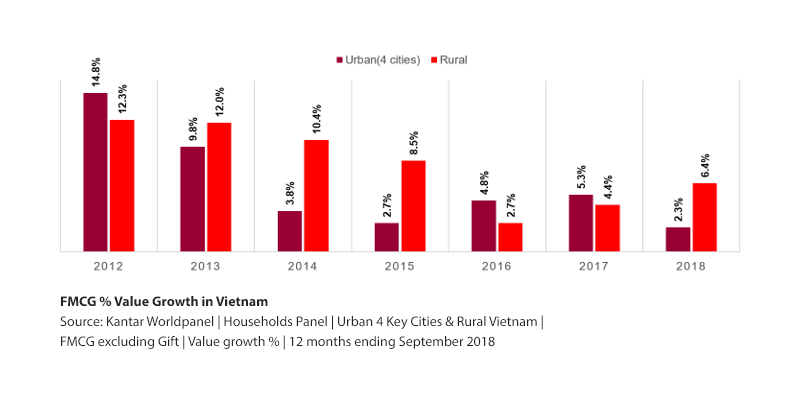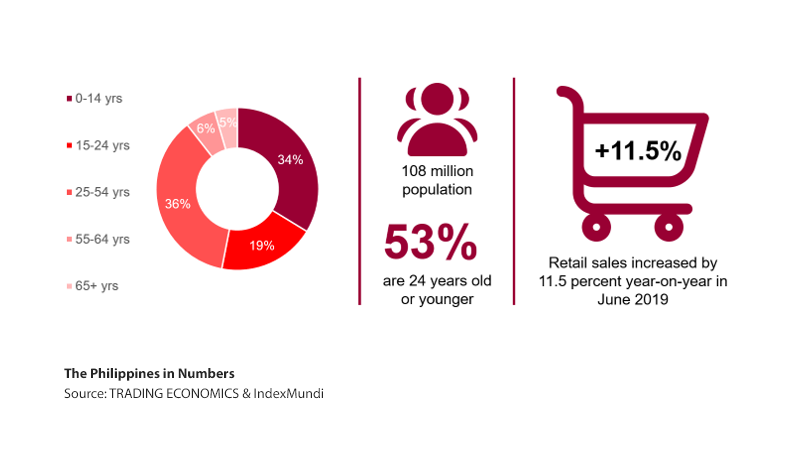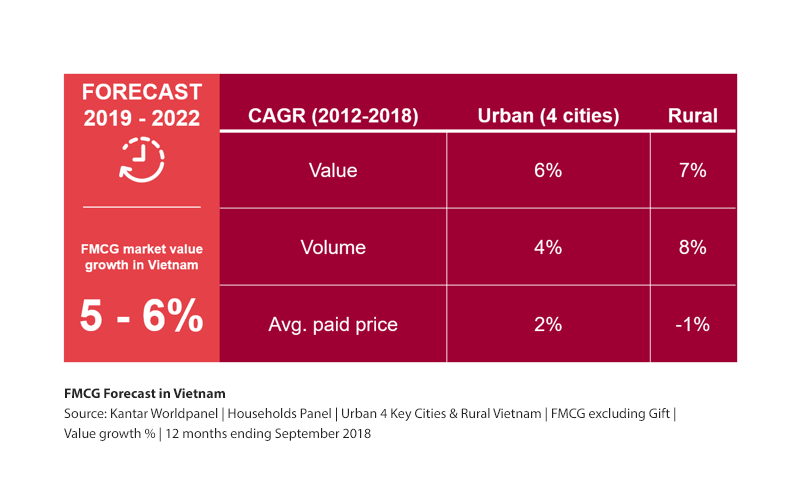Vietnam and the Philippines were the two leading countries in Southeast Asia within FMCG last year, according to a recent consumer report from Nielson about Southeast Asia. Vietnam’s FMCG sales growth reached 5.2%, second in Southeast Asia behind the Philippines 8.7%. Global FMCG sales growth was only 3.4%, but Asian markets benefitted from buoyant economic factors and strong consumer confidence, according to the report.
Vietnam
Vietnam’s economy remained strong with GDP growth of 7.1% supported by all sectors in 2018.
There was also a rise in connected consumers in Vietnam. The sustained growth in economy and infrastructure also gave rise to the significant chunk of connected consumers which today contribute to a USD 50Bn in annual spending (38% of total spending), and were expected to reach USD 99Bn in annual spending (48% of total spending) by 2025 according to a recent study by Nielsen.
This overall growth in economy have also led to channel fragmentation to match the evolving and fast paced need of the consumers. This resulted in strong growth within e-commerce, specialty stores and Modern Trade. Modern Trade in particular were a bright spot growing at 13% enabled by explosion in smaller format stores. However, this channel was not easy to crack with higher competition from local players, imported products and private labels.

The Philippines
The Philippines’ economy remained strong as well and is one of the emerging markets in South East Asia poised for economic growth because of its consistently strong GDP performance of 6-7% over the last 5 years.
The country has one of the youngest populations in the world. 52% of the total population (107 million) are 23 years old or younger, and the country’s median age is 24, which means a healthy and growing labor force and sustained future consumption.
The Philippines has also experienced an emerging middle class with a rise in spending power. There are especially two consumer bases contributing to this growth, business process outsourcing (BPO) workers and overseas Filipino workers’ (OFW) families. OFWs now account for about 10-12 million Filipinos, and their regular remittances to their families make up 10% of the country’s GDP. Meanwhile, BPOs continue to open up and expand in various cities in the country, employing over 1 million young workers. The continuous growth of both these sectors, whose earnings are way higher than the average Filipino families, lead to higher spending power and aspirational lifestyles.

Looking at the entire Southeast Asia region we see that improved spending power has led to healthy FMCG growth in the entire region. Almost all of the countries have had a positive FMCG growth in 2018.

The majority of Southeast Asian consumers finally believe that they are financially better off than they were five years ago, particularly the consumers from developing economies such as Vietnam, Indonesia and the Philippines.
But not only are the consumers financially better off than before, they are also able to spend more comfortably and buy things simply based on their desire. Almost half of the population in both Vietnam and the Philippines live comfortably and are able to buy some things just because they want to.
Both of the countries are facing a bright future. It will be exciting to keep track of developments in these two countries in the near future, as the high digital connectivity increases, the consumer confidence follows.
Read more about our consulting services.
The insights provided in this article are for general informational purposes only and do not constitute financial advice. We do not warrant the reliability, suitability, or correctness of the content. Readers are advised to conduct independent research and consult with a qualified financial advisor before making any investment decisions. Investing in financial markets carries risks, including the risk of loss of principal. Past performance does not guarantee future results.
The views expressed herein are those of the author(s) and do not necessarily reflect the company's official policy. We disclaim any liability for any loss or damage arising from the use of or reliance on this article or its content. ARC Group relies on reliable sources, data, and individuals for its analysis, but accuracy cannot be guaranteed. Forward-looking information is based on subjective judgments about the future and should be used cautiously. We cannot guarantee the fulfillment of forecasts and forward-looking estimates. Any investment decisions based on our information should be independently made by the investor.
Readers are encouraged to assess their financial situation, risk tolerance, and investment objectives before making any financial decisions, seeking professional advice as needed.





